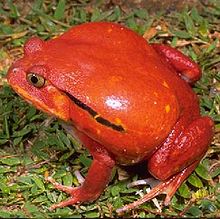Dyscophus antongilii
| Tomato frog | |
|---|---|
 |
|
| Scientific classification | |
| Kingdom: | Animalia |
| Phylum: | Chordata |
| Class: | Amphibia |
| Order: | Anura |
| Family: | Microhylidae |
| Genus: | Dyscophus |
| Species: | D. antongilii |
| Binomial name | |
|
Dyscophus antongilii Grandidier, 1877 |
|
The Madagascar tomato frog or crapaud rouge de Madagascar (Dyscophus antongilii) is a species of frog in the family Microhylidae.
Females are much larger than males, reaching up to 10.5 cm and 230 g in weight (6.5 cm and 41 g for males). Tomato frogs live up to their name by possessing a vibrant, orange-red colour. Females are much larger than males and have brighter tones of red or orange on their back, with a pale undersurface. Some individuals also have black spots on the throat. It is thought that the brilliant colours of the tomato frog act as a warning to potential predators that these frogs are toxic; a white substance secreted from the skin acts as a glue to deter predators (such as colubrid snakes) and can produce an allergic reaction in humans.
Endemic to Madagascar, tomato frogs are found in the northeast of the island around Antongil Bay (from which they gain their specific name, antongilii), and south to Andevoranto. The exact distribution of this species is unclear however, due to confusion with the closely related D. guineti.
The tomato frog breeds in shallow pools, swamps and areas of slow-moving water. These frogs are found from sea level to elevations of around 200 metres. Its natural habitats are subtropical or tropical moist lowland forests, rivers, swamps, freshwater marshes, intermittent freshwater marshes, arable land, plantations, rural gardens, urban areas, heavily degraded former forest, ponds, and canals and ditches.
Tomato frogs breed in February to March following heavy rainfall; the sounds of males calling to attract females can be heard around small water bodies in the dark Malagasy night. Following copulation, females will lay a clutch of 1,000 to 15,000 eggs on the surface of the water. Tadpoles hatch from these small black and white eggs about 36 hours later; they are only around six millimetres long and feed by filter-feeding. Tadpoles undergo metamorphosis into yellow juveniles and this stage is completed around 45 days after the eggs were laid.
...
Wikipedia

